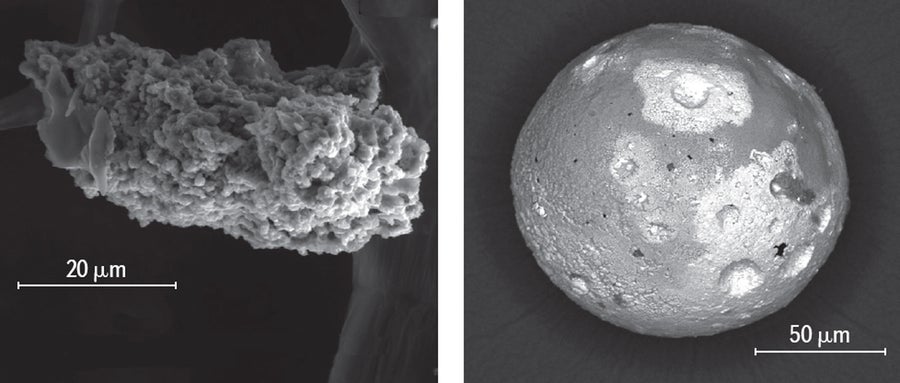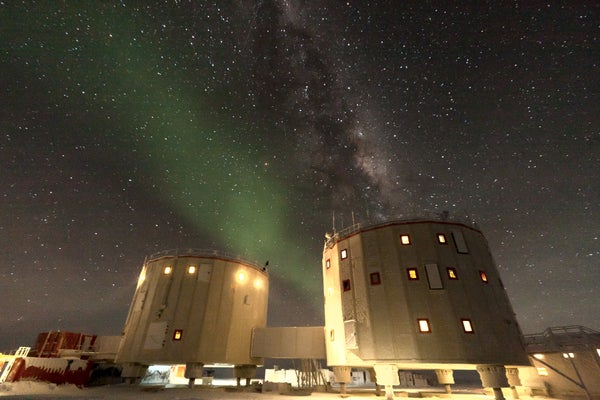Earth’s surface is constantly sprinkled with space dust. Extraterrestrial material has rained down on our planet throughout its multi-billion-year history—and the celestial shower continues each passing day. Sizable chunks of rock and metal are the most dramatic examples, appearing as brilliant shooting stars during their fiery passage through the upper atmosphere and occasionally reaching the ground to become meteorites. But most of the space stuff that falls to Earth is quite small, submillimeter in size.
In the past, researchers have sought to gauge the amount of such micrometeorites that reach Earth over time, but parsing cosmic dust is difficult on a planet that constantly whirls dust of its own making.
Now, in a study recently published in Earth and Planetary Science Letters, a team measuring micrometeorite accumulation in the pristine snow of Antarctica has provided the best-yet estimate for incoming extraterrestrial debris. With clean sampling techniques and accurate ages for dust deposits, the researchers calculated around 5,200 metric tons of micrometeorites fall to Earth every year.
On supporting science journalism
If you're enjoying this article, consider supporting our award-winning journalism by subscribing. By purchasing a subscription you are helping to ensure the future of impactful stories about the discoveries and ideas shaping our world today.
The Perfect Place for Space Dust
Polar regions, such as Greenland and Antarctica, that are covered with ice year-round are hot spots for micrometeorite research because of their geographical isolation and stasis. Scant material from elsewhere on Earth reaches those remote regions, allowing the barely changing ice sheets to soak up space dust with minimal contamination. The enduring ice also gives researchers a way of marking the age of micrometeorites, denoted by annual snow layers that persist year after year.
Although both poles have potential for micrometeorite research, Jean Duprat, a cosmochemist at the University of Paris–Saclay, prefers the southern ice. “The South Pole is by far the best because you are surrounded by oceans—you are completely isolated from mainlands,” says Duprat, who is a co-author of the study.
In three field seasons stretched across the past two decades, Duprat and his colleagues visited the French-Italian Concordia station at a region called Dome C in Antarctica to collect micrometeorites. Located 1,100 kilometers inland on the continent and rising more than three kilometers above sea level, Dome C is practically perfect for cosmic dust collecting.
Julien Rojas, a doctoral student at the University of Paris–Saclay and lead author of the study, notes that snowfall at Dome C has “quite low accumulation rate, but it’s enough to shield and preserve the particles.” The resulting thinness of each year’s layer of snow, Rojas says, allowed the team to collect decades of annual micrometeorite deposits in one location without having to melt huge amounts of ice.

Antarctic micrometeorites. Credit: © J. Duprat, C. Engrand and CNRS
A Close-up of Cosmic Dust
The researchers began their work with deposits dated to years before 1995, and then they excavated deeper, earlier layers. This was meant to avoid any human contamination from the establishment of the field station at Concordia, which began in earnest in 1996.
Over the years, Duprat came to realize that the researchers themselves were inadvertently importing small but significant amounts of terrestrial dust to the site, contaminating their samples. Careful adjustments to collection and handling eventually fixed the problem: each snow sample was sealed in a polyethylene barrel, then transported to a clean room for melting and sieving.
After filtering the dust from the snow, the team used electron microscopy, x-ray spectroscopy and other techniques to analyze more than 2,000 particles ranging from 12 to 700 microns. Space-sourced dust usually displays several telltale giveaways—for instance, a spherical shape (from melting during atmospheric entry) or a distinctly unearthly distribution of chemical isotopes. The array of analysis methods allowed the team not only to identify cosmic dust but also to trace each extraterrestrial particle’s most likely origin.
“We tried to focus on the unmelted micrometeorites, which are poorly collected in other collections because they are very fragile and can be destroyed easily,” Rojas says. “Our collection protocol allows us to preserve it.”
The team found that more than 60 percent of the dust probably originated from Jupiter family comets, which are herded into orbital periods of less than 20 years by the giant planet’s gravitational influence. About 20 percent of the dust likely came from the main asteroid belt. “The dust from comets is fluffier than from asteroids,” Rojas says, adding that the cometary material also tends to be richer in organic matter, which is typical of Jupiter family comets.
“Meteorites and cosmic dust are these really nice complementary sets of astromaterials,” says Marc Fries, a planetary scientist and curator of NASA’s Cosmic Dust Collections, who was not involved in the study. He explains that asteroids tend to be cohesive, rocky bodies that leave behind chunks and shards on Earth’s surface. “Comets are not as cohesive,” he says, adding that the loose “fluffy” material easily disintegrates, leading to deposits of cosmic dust.
Organic compounds from cosmic dust could have been vitally important for life’s origins on Earth, Fries says. Falling space dust “probably added a sizable contingent of the total amount of volatiles to the Earth’s surface: water, carbon and other materials that were important for prebiotic chemistry and for the rise of life,” he adds. “Understanding the full range of composition of these particles gives us a snapshot of the composition of the inner solar system—the small bodies in particular.”
Once the researchers had successfully extracted the dust and charted its abundance against the year-by-year clock set by the annual snowfalls at Dome C, they could calculate the flux of incoming extraterrestrial dust. When it scaled up the Dome C measurements to the entire planet, the team found that between 4,000 and 6,700 metric tons of space dust falls to Earth each year.
The range of dust tonnage is essentially a matter of statistics, reflecting the inherent difficulty of extrapolating a global effect from a very complex series of limited, local measurements. “Depending on the volume of snow, you would expect a certain uncertainty by just counting the particles,” Rojas says.
Kate Burgess, a geologist at the U.S. Naval Research Laboratory, who was not involved in the research, is impressed by the study but cautions that its estimate cannot be the final word. “Counting hundreds and hundreds of particles—it’s just so much work to try to get enough particles to have good enough statistics to take away any kind of statistical error in that number,” she notes.
In particular, Burgess says, the dust input from comets can fluctuate over time, depending on the vagaries of orbital mechanics, comet outgassing rates and a host of other variables that are not necessarily well understood. “These [are] transient sources,” she explains. “If they're from a specific Jupiter family comet, those come by periodically and relatively regularly but not constantly.”
One Small Step
While those in the extraterrestrial dust community have known that thousands of metric tons of dust land on Earth every year, Burgess praises the researchers for being “able to put tighter constraints on the amount of time over which these micrometeorites accumulated than some of the previous studies.”
“From our perspective inside the community, this is a really good bit of work,” she says. Fries agrees, adding that “the scientific community has a long-standing desire for exactly the kind of samples that this team collected”—that is, samples that are fresh, clean and gathered with painstaking precision and care.
Coincidently, this year marks the 40th anniversary of NASA’s Cosmic Dust Collections. Already, Fries says, his colleagues are wondering how they might acquire some of these precious specimens from the South Pole. “These are sought after by scientists,” he says. “This is very timely.”
A version of this article with the title “When the Dust Settles” was adapted for inclusion in the July 2021 issue of Scientific American.
